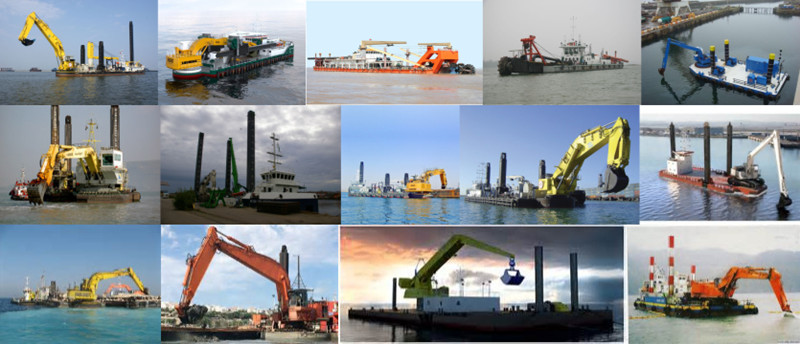Bucket dredgers can be used in almost every type of soil, from mud to soft rock. When rock has been fragmented by blasting, bucket dredgers are often used, because of their relative lack of sensitivity to variations in the size of the stones. The capacity of a Bucket Dredger is expressed in terms of the content of the buckets. The capacity of a bucket can vary between 50 and 1200 litres. Rock bucket dredgers often have a double set of buckets, the small rock buckets and the large mud buckets. This is in order to make better use of the power of the Dredger and to widen the range of its use.
Photo of our Bucket Dredger:

Important factors
1. The production capacity
The production capacity of a bucket dredger cannot be increased indefinitely. Increasing the production capacity of bucket dredgers implies increasing the bucket capacity. This means that the forces in the bucket chain resulting from the weight of the buckets and links themselves is also greatly increased. This in turn demands an even heavier construction. The production capacity of bucket dredgers therefore seldom rises above 100.000 m³/week. The same goes, to an even greater degree, for the dredging depth, because greater dredging depths demand longer bucket ladders and thus more buckets.
2. The dredging depth
As with other dredgers both the maximum and minimum dredging depths are very important in relation to the use of the dredger. Requirements in relation to these values are closely related to market demands. The difference between the maximum and minimum dredging depth determine the change of the angle of the bucket rim with the horizon.
3. The soil
The influence of the soil to be dredged is seen in the power of the upper tumbler, the strength of the ladder, links and buckets and also in the bucket capacity and shape. If a bucket dredger is equipped with buckets for both soft soil and rock, the capacity of the rock buckets is roughly 60 to 70% of that of the soft soil buckets. Naturally, the length of the links must be the same for both types of bucket. The length of the link must be the same.
Moreover rock buckets are usually cast and soft soil buckets are often welded.
4. The transport of the dredged material
Usually barges that are loaded while moored alongside the dredger are used to transport the dredged material. The height of the main Gantry must be such that the soil falling from the buckets can slide down into the barges moored alongside via the chute.
5. The bucket dredger with a pipeline discharge system
Sometimes the dredged material is carried away directly. In these cases it is collected in a hopper and mixed with the right amount of water to be transported by means of a dredged pump and pipeline. As in the case of a Cutter Suction Dredger, the floating pipeline is attached to the stern of the dredger.
Naturally a Barge with a dredge pump can also be moored alongside the dredger for this purpose. This option is increasingly rarely used; indeed, unless the work stipulates the use of a bucket dredger the contractor will employ the much cheaper cutter suction dredger.
The design of Bucket Dredger
When designing bucket dredgers the following design parameters are important:
• Production capacity
• Dredging depth (minimum and maximum)
• Soil type
• The discharge of the dredged material (barges or via pipeline)
As previously mentioned, the bucket dredger can be used in all types of soil from clay to soft rock which has not been blasted and hard rock which has been fragmented by blasting. The type of soil to be dredged has a big influence on the design and the construction of the dredger. Considerable forces arise during the dredging of rock. For all types of soil it is necessary to know the required cutting capacity and the energy that is needed to transport the dredged material via the bucket chain to the upper tumbler.
Bucket Dredger
Bucket Ladder Dredger,Bucket Wheel Dredger,Clamshell Bucket,Bucket Chain Dredger
Unisite Group Ltd. , https://www.shipsparts.nl
